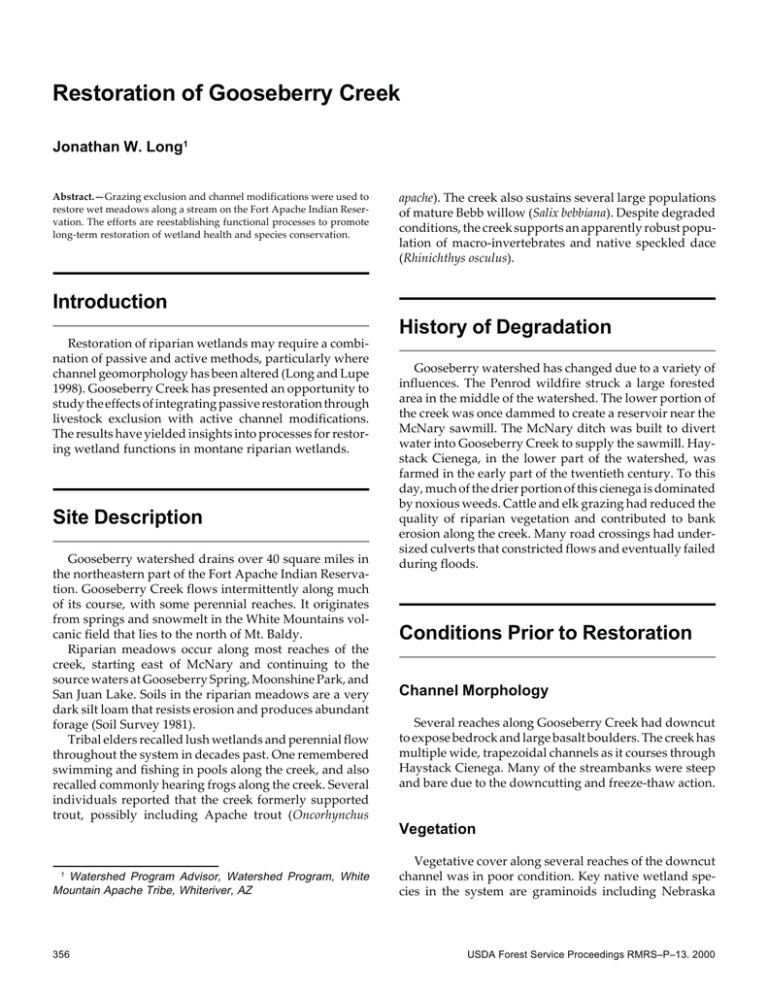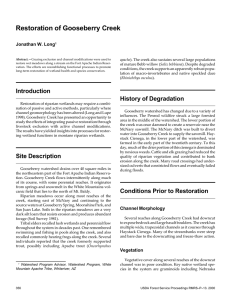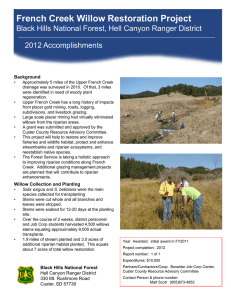Restoration of Gooseberry Creek Jonathan W. Long apache
advertisement

Restoration of Gooseberry Creek Jonathan W. Long1 Abstract.—Grazing exclusion and channel modifications were used to restore wet meadows along a stream on the Fort Apache Indian Reservation. The efforts are reestablishing functional processes to promote long-term restoration of wetland health and species conservation. apache). The creek also sustains several large populations of mature Bebb willow (Salix bebbiana). Despite degraded conditions, the creek supports an apparently robust population of macro-invertebrates and native speckled dace (Rhinichthys osculus). Introduction History of Degradation Restoration of riparian wetlands may require a combination of passive and active methods, particularly where channel geomorphology has been altered (Long and Lupe 1998). Gooseberry Creek has presented an opportunity to study the effects of integrating passive restoration through livestock exclusion with active channel modifications. The results have yielded insights into processes for restoring wetland functions in montane riparian wetlands. Site Description Gooseberry watershed drains over 40 square miles in the northeastern part of the Fort Apache Indian Reservation. Gooseberry Creek flows intermittently along much of its course, with some perennial reaches. It originates from springs and snowmelt in the White Mountains volcanic field that lies to the north of Mt. Baldy. Riparian meadows occur along most reaches of the creek, starting east of McNary and continuing to the source waters at Gooseberry Spring, Moonshine Park, and San Juan Lake. Soils in the riparian meadows are a very dark silt loam that resists erosion and produces abundant forage (Soil Survey 1981). Tribal elders recalled lush wetlands and perennial flow throughout the system in decades past. One remembered swimming and fishing in pools along the creek, and also recalled commonly hearing frogs along the creek. Several individuals reported that the creek formerly supported trout, possibly including Apache trout (Oncorhynchus Gooseberry watershed has changed due to a variety of influences. The Penrod wildfire struck a large forested area in the middle of the watershed. The lower portion of the creek was once dammed to create a reservoir near the McNary sawmill. The McNary ditch was built to divert water into Gooseberry Creek to supply the sawmill. Haystack Cienega, in the lower part of the watershed, was farmed in the early part of the twentieth century. To this day, much of the drier portion of this cienega is dominated by noxious weeds. Cattle and elk grazing had reduced the quality of riparian vegetation and contributed to bank erosion along the creek. Many road crossings had undersized culverts that constricted flows and eventually failed during floods. Conditions Prior to Restoration Channel Morphology Several reaches along Gooseberry Creek had downcut to expose bedrock and large basalt boulders. The creek has multiple wide, trapezoidal channels as it courses through Haystack Cienega. Many of the streambanks were steep and bare due to the downcutting and freeze-thaw action. Vegetation 1 Watershed Program Advisor, Watershed Program, White Mountain Apache Tribe, Whiteriver, AZ 356 Vegetative cover along several reaches of the downcut channel was in poor condition. Key native wetland species in the system are graminoids including Nebraska USDA Forest Service Proceedings RMRS–P–13. 2000 sedge (Carex nebrascensis), sawbeak sedge (Carex stipata), beaked sedge (Carex utriculata), woolly sedge (Carex lanuginosa), spikerush (Eleocharis sp.), burreed (Sparganium sp.) and rushes (Juncus sp.). Tall, mature bebb willows are scattered throughout the riparian meadows. The only other woody riparian plants in the system are a few other willow species (Salix sp.) that grow in association with beaver dams and the gooseberries (Ribes sp.) for which the creek is named. Restoration treatments Restoration treatments were selected to address many of the various impacts that had degraded the creek. A key strategy was to promote recovery by protecting wetland vegetation from grazing. However, the degraded channels required active intervention to speed the natural recovery process. Funding support for the project came from a variety of sources, including tribal programs, the Arizona Water Protection Fund, and a U.S. Fish and Wildlife Service Challenge Cost-Share award. with a low-water crossing using large (1 square meter) rectangular rocks to create a french drain. Revegetation The riparian meadows were reseeded with various native species including Baltic rush (Juncus balticus), tufted hairgrass (Deschampsia caespitosa), Nebraska sedge and beaked sedge. The seeds were sown during the late fall and early winter of 1997-1998. Riffle Bars Two reaches between Haystack Cienega and the Bebb Willow stand were treated by augmenting existing riffle features. In this method, a mixture of gravels, cobbles, and fine particles were added to riffles using heavy equipment. This approach recreates natural structural controls in the system. We observed many tall riffles composed of gravels, cobbles, and basalt boulders throughout Gooseberry Creek. These features are particularly pronounced in the intermittent reaches, as revealed in longitudinal profiles at the site (Watershed Program unpublished data). Grazing Management The first stage in restoration was to redesign the livestock management for the area. The range management plan for both livestock associations in the area were revised. The range conservationist worked to reduce the number of animals brought to this summer range. The next stage was to construct fences around key riparian areas to promote recovery of vegetation. Members of the livestock associations constructed many of the new fences. The range management plans provided for keeping livestock out of these riparian areas to promote growth of wetland vegetation. To offset these impacts, several drinkers were constructed outside of the riparian areas. A challenge to the plan was the large number of elk that also grazed the riparian areas. Road Crossing Redesign A major element of the restoration treatments were reconstruction of road crossings. One crossing in the upper watershed had a single undersized culvert replaced with three large culverts. Despite the increased capacity, this culvert has continued to suffer temporary blockages during spring runoff as debris has lodged in one or more of the culverts. A second culvert crossing was replaced USDA Forest Service Proceedings RMRS–P–13. 2000 Results Many of the reaches along Gooseberry Creek have responded dramatically to the restoration treatments. The rest afforded the creek has promoted natural processes of morphological development. However, some reaches remain dysfunctional due to altered channel morphology. The reach east of McNary has lush growth of wetland vegetation that thoroughly covers the stream bed and banks. The stream itself ceases to flow after spring runoff, but the area remains a hospitable wetland. The reach between Haystack Cienega and the Bebb Willow stand has improved with vigorous growth of spikerush and Nebraska sedge in the channel bottom. Because we used seeds from plants that already existed at the site, we have been unable to determine how much of this growth is attributable to reseeding. However, we did observe sedge seedlings in the channel, suggesting that this effort may have been at least partially successful. Spring runoff in 1998 and 1999 caused the augmented riffles to sink and moved some of the fine materials, but those particles appeared to be redeposited within the channel and then trapped by the vegetation. The french drain road crossing permits spring runoff to spread across the full width of the meadow and deposit sediments. 357 Although the riffles have been redistributed somewhat, we have not observed significant bank erosion in the treated reaches despite high flows during spring runoff. Reaches within Haystack Cienega and at the Bebb Willow Stand have responded to grazing exclusion with growth of in-channel vegetation. However, the downcut channels and steep banks in these reaches have limited recovery. Active intervention is needed to restore these channels. The meadow at Neagle Ranch, which was treated with fencing and reseeding, has grown vigorously with native wetland vegetation. Natural stream deposition is significant in this reach due to a high bedload during spring flows. The deposition has caused rewetting of the riparian meadow. The channel is continuing to reestablish a stable morphology, and some of the stream banks are still raw and steep. The creek from this reach to the headwaters has mostly perennial flow and represents the best potential trout habitat. However, the water level in the creek still drops precipitously during the early summer. The deficiency of summer flows and overhanging streambanks have thus far discouraged us from reintroducing native trout to the watershed. We are hopeful that the recovery process will continue to reestablish conditions that will permit reintroduction. The creek is unlikely to ever become a viable fishery, but it can serve as a refugia for the native biota of the White Mountains. Conclusion Combinations of passive and active restoration treatments have promoted recovery of riparian meadows in 358 the Gooseberry watershed. In some reaches, passive restoration through grazing exclusion and removal of culverts have reestablished functional processes such as riffle formation and bank development. These processes are serving to rewet the riparian meadows. In other reaches, degraded channel morphology prevents the same processes from occurring. This project demonstrates the value of integrating restoration treatments to promote longterm ecological restoration. Acknowledgments The author wishes to thank Laurel Lacher, White Mountain Apache Tribe, and Leslie Ruiz, Arizona Fishery Resources Office, for their gracious technical reviews of this paper. Literature Cited Long, J.W. and Lupe, C.S. 1998. A process for planning and evaluating the success of riparian-wetland restoration projects on the Fort Apache Indian Reservation. Hydrology and Water Resources in Arizona and the Southwest 28:68-74. Soil Survey. 1981. Soil survey of Fort Apache Indian Reservation, Arizona. Parts of Apache, Gila, and Navajo counties. USDA Soil Conservation Service and USDI Bureau of Indian Affairs, in cooperation with Arizona Agricultural Experiment Station. USDA Forest Service Proceedings RMRS–P–13. 2000





